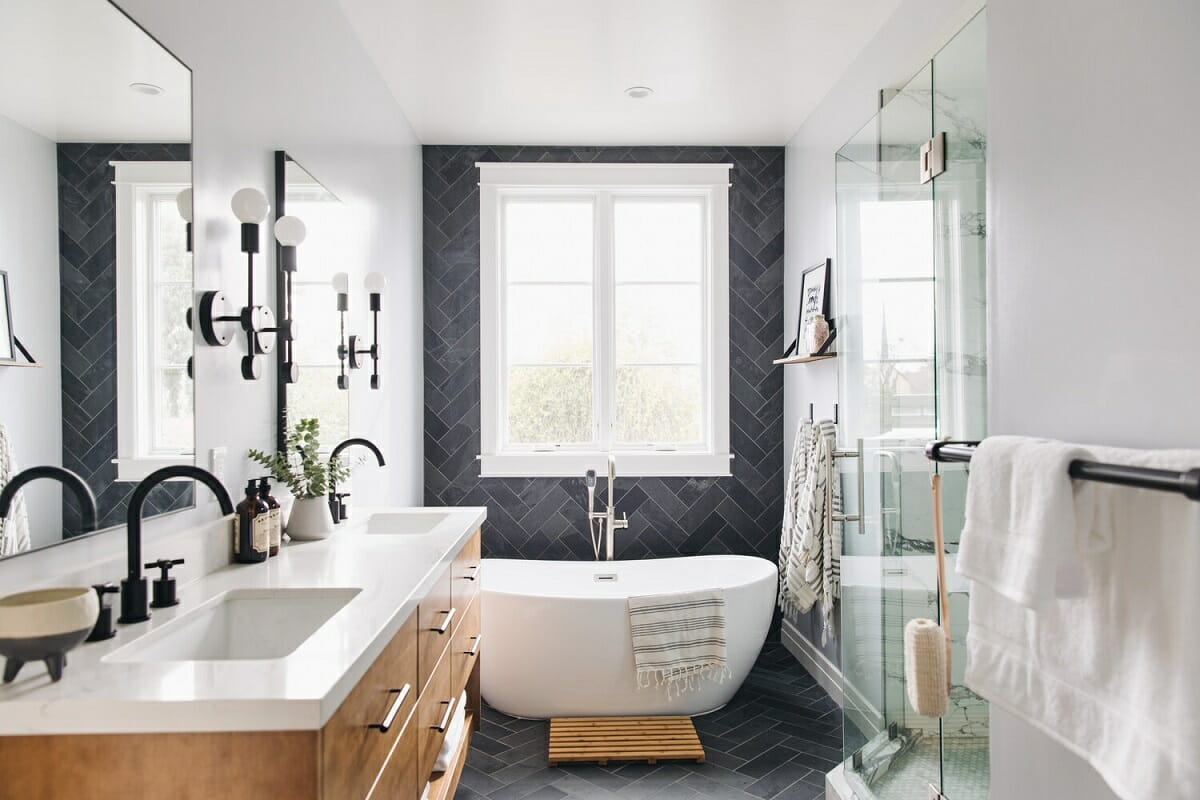When designing or renovating a home, one of the most important considerations is the size and layout of the bathrooms. Bathrooms are essential spaces that need to balance functionality, comfort, and aesthetics. Determining the average bathroom size for your home involves understanding standard dimensions, considering your specific needs, and factoring in the type of bathroom you’re planning (e.g., full bathroom, half bathroom, or ensuite). This guide will walk you through the process of determining the ideal bathroom size for your home.
1. Understand Standard Bathroom Sizes
Before deciding on the size of your bathroom, it’s helpful to know the average dimensions for different types of bathrooms. These standards can serve as a starting point for your design:
Full Bathroom (with shower and bathtub)
- Average Size: 40–60 square feet (3.7–5.6 square meters)
- Typical Dimensions: 5×8 feet, 6×10 feet, or 8×8 feet
- Features: Toilet, sink, bathtub, and shower (or a shower-tub combo).
Three-Quarter Bathroom (with shower but no bathtub)
- Average Size: 30–40 square feet (2.8–3.7 square meters)
- Typical Dimensions: 6×6 feet or 5×7 feet
- Features: Toilet, sink, and shower.
Half Bathroom (powder room)
- Average Size: 15–20 square feet (1.4–1.9 square meters)
- Typical Dimensions: 4×5 feet or 5×6 feet
- Features: Toilet and sink.
Ensuite Bathroom (attached to a bedroom)
- Average Size: 40–100 square feet (3.7–9.3 square meters)
- Typical Dimensions: Varies depending on the bedroom size and layout.
- Features: Toilet, sink, shower, and sometimes a bathtub or additional amenities like double vanities.
Master Bathroom
- Average Size: 100–200 square feet (9.3–18.6 square meters)
- Typical Dimensions: 10×10 feet, 12×12 feet, or larger.
- Features: Toilet, double sinks, separate shower and bathtub, and sometimes a walk-in closet.
2. Assess Your Needs and Priorities
The size of your bathroom will depend on how you plan to use the space. Consider the following factors:
Number of Users
- Will the bathroom be used by one person, a couple, or an entire family? More users typically require more space, especially for storage and multiple fixtures.
Type of Bathroom
- A half bathroom (powder room) for guests requires less space than a full bathroom or master ensuite. Decide whether you need a shower, bathtub, or both.
Storage Requirements
- Do you need space for towels, toiletries, and cleaning supplies? Built-in cabinets, shelves, or a linen closet will add to the overall size.
Accessibility
- If you’re designing a bathroom for aging family members or individuals with mobility challenges, you may need to allocate more space for features like grab bars, walk-in showers, or wheelchair accessibility.
Luxury Features
- If you want to include luxury elements like a soaking tub, double vanities, or a steam shower, you’ll need a larger bathroom.
3. Consider the Layout and Fixture Placement
The layout of your bathroom plays a significant role in determining its size. Here are some tips for optimizing space:
Minimum Clearances
- Ensure there’s enough space around each fixture for comfortable use. For example:
- Toilet: At least 21 inches of clearance in front.
- Sink: 30 inches of width per person.
- Shower: 30×30 inches minimum for a small shower; 36×36 inches for a more comfortable size.
- Bathtub: Standard tubs are 60 inches long and 30–32 inches wide.
Traffic Flow
- Plan for easy movement within the bathroom. Avoid placing fixtures too close to each other, and ensure doors can open without obstruction.
Wall Space
- Consider the placement of windows, doors, and plumbing when designing the layout. These elements can limit where fixtures can be placed.
4. Evaluate Your Available Space
The size of your bathroom will ultimately depend on the space available in your home. Here’s how to evaluate your options:
Existing Bathrooms
- If you’re renovating, measure your current bathroom to determine if you can work within the existing footprint or if you need to expand.
New Construction
- For new builds, consider the overall size of your home and how much space you can allocate to bathrooms. Larger homes typically have larger bathrooms.
Space-Saving Solutions
- If space is limited, consider compact fixtures like corner sinks, wall-mounted toilets, or sliding doors to maximize functionality.
5. Research Local Building Codes
Before finalizing your bathroom size, check local building codes and regulations. These codes may dictate:
- Minimum room dimensions.
- Required clearances around fixtures.
- Ventilation and lighting requirements.
- Accessibility standards (if applicable).
Compliance with building codes is essential to ensure safety and avoid costly revisions later.
6. Work with a Professional
If you’re unsure about the ideal bathroom size or layout, consult an architect, interior designer, or contractor. These professionals can help you:
- Optimize the use of available space.
- Choose fixtures and materials that fit your budget and style.
- Ensure the design meets building codes and accessibility standards.
7. Plan for Future Needs
When determining the size of your bathroom, think about your long-term needs. For example:
- If you plan to sell your home in the future, consider resale value. Larger, well-designed bathrooms are often a selling point.
- If your family is growing, you may need more space for additional users or storage.
8. Examples of Bathroom Sizes
Here are some examples of bathroom sizes based on common layouts:
Small Full Bathroom (5×8 feet)
- Ideal for a single user or small family.
- Includes a toilet, sink, and shower-tub combo.
Medium Full Bathroom (6×10 feet)
- Offers more space for storage and movement.
- Can accommodate a separate shower and bathtub.
Large Master Bathroom (12×12 feet)
- Includes double vanities, a separate shower, a soaking tub, and ample storage.
- Suitable for couples or those who want a luxurious retreat.
Conclusion
Determining the average bathroom size for your home involves balancing standard dimensions, your specific needs, and the available space. Whether you’re designing a compact powder room or a spacious master ensuite, careful planning and attention to detail will ensure a functional and comfortable bathroom. By considering factors like fixture placement, storage, and future needs, you can create a bathroom that meets your requirements and enhances your home’s overall appeal. If in doubt, don’t hesitate to seek professional guidance to bring your vision to life.




